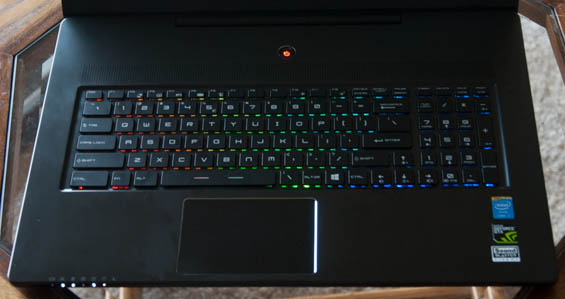iBuyPower Battalion M1771 (MSI GS70) Gaming Notebook Review
by Dustin Sklavos on December 30, 2013 2:45 PM ESTIt's true the iBuyPower Battalion M1771 (MSI GS70) cribs from Razer's playbook (in turn cribbing very liberally from Apple's), but it's also a smart choice on MSI's part. Even if you're not among the Apple devoted (and happily I'm not), it's difficult to find too much fault with Apple's industrial design on their notebooks. Lifting that, painting it black, and sticking it on a gaming notebook is a pretty solid plan, all things considered.
The GS70's chassis is all black brushed aluminum, and it's a fairly smart and sleek design. MSI says it's styled like a stealth fighter; however they want to qualify it, it's in the right direction. It's also actually ever so slightly smaller in every dimension than the Razer Blade Pro, and lighter too. This is no mean feat; Razer's engineering on the 2013 Blade Pro is pretty impressive in its own right. Given the near identical specs between the GS70 and the current Blade Pro, it's not hard to imagine this notebook as a torpedo aimed squarely at Razer.
Where the bag mixes is the keyboard and touchpad. The keyboard features subdued user-configurable RGB backlighting and has decent enough response if a little mushy and with poor travel (par for the course in a notebook this thin); while I don't like that MSI is continuing to use exactly the same chassis for international and North American notebooks and thus has a slightly awkward and fouled up keyboard layout, it's at least livable. I just wish they'd do a better job adapting the layout, since that's something that can be handled in software. Having Home and End shared with Page Up and Page Down is frustrating for people who do a lot of writing, especially when we have literally no use for Scroll Lock or Pause/Break.
The clickpad, while attractive with its silver aluminum trim, is nigh unusable. Response and traction are poor. This is something that could have and should have been a homerun; the Switchblade UI is a decent amount of the cost of the Razer Blade Pro and its placement on that notebook is awkward. If you're not a fan of it and wanted a more traditional keyboard and touchpad with a physical 10-key, MSI could've nailed it, but the poor quality touchpad could be enough to drive you back into the Switchblade's arms.
While MSI and iBuyPower don't expect you to crack open the GS70, it can be done with a modicum of patience. There are 17 screws on the bottom of the GS70 that have to be removed before you can take off the shell. You get a good idea of the smart internal layout, though; the fans intake air from the bottom and exhaust it out of the sides, cooling the GPU and CPU separately, and it's actually remarkably quiet given the dimensions of the notebook. MSI also makes effective use of internal real estate; by having moved the keyboard down slightly they placed all of the hotter components above it where they can get a little bit more headroom. The battery and 2.5" bay then live in the wrist rest, keeping it cool.



_thumb.jpg)
_thumb.jpg)
_thumb.jpg)
_thumb.jpg)
_thumb.jpg)
_thumb.jpg)









37 Comments
View All Comments
DanNeely - Tuesday, December 31, 2013 - link
No. Except for anything they buy out of pocket or what is donated to create testbeds its mostly loaners so that the manufacture can get a half dozen reviews out of a single piece of hardware.Kristian Vättö - Wednesday, January 1, 2014 - link
It depends on the review item, publication and company/region. Typically expensive items like notebooks and smartphones have to be sent back but I've only had to send back two or three SSDs and that's because I've dealt with companies' European offices (they have more limited marketing budgets).johnxfire - Wednesday, January 1, 2014 - link
Will we we ever get a review on the W230ST? Its probably my favorite piece of hardware ever, coming from my NP8150 to that has been an amazing move. It saddens me that Clevo resellers arent as popular as they ought to be.hfm - Thursday, January 2, 2014 - link
I seem to recall all the reviews saying it sounded like a jet engine during gameplay. One of these days we'll get a nice thin and like gaming laptop (4-6 lb depending on size) .. I think the 14" around 4-4.5 and 15-17 maxing around 5.75-6lb are good spots..hfm - Thursday, January 2, 2014 - link
I meant to say something these sizes and weight that don't sound like they are about to take off during gaming..Hubszo - Thursday, January 9, 2014 - link
You're pointing lack of 802.11ac connectivity and it sounds pretty logical considering today's WiFi development. But what surprise me the most that Anandtech has so far not taken proper focus on the widespread issues (some even say about law suit) regarding the most common 802.11ac solution in the form of Intel AC 7260 (specially if utilized under Windows 8.1). It is now several months with this unsolved problem where signal and connection drop-outs are making customers furious and disappointed with Intel's lack of proper action. Personally I own MS-1757 (MSI GT70) with the mentioned WiFi card and I have unfortunately joined huge group of unhappy users (66 sides of posts on Intel's forum speaks for itself) regardless that entire machine pleases me a lot..Ananadtech always was (and still is) my favorite source of IT info, pointing pitilessly bugs, design flaws and "scams" but I just don't understand why is so little attention here on this subject where its negative impact on WiFi experience is so obvious.
Innokentij - Tuesday, January 14, 2014 - link
Why dont you check for throttling issues when you review laptop gaming? 1 hour of gaming with fraps running to check is a must if you want to review a gaming notebook.